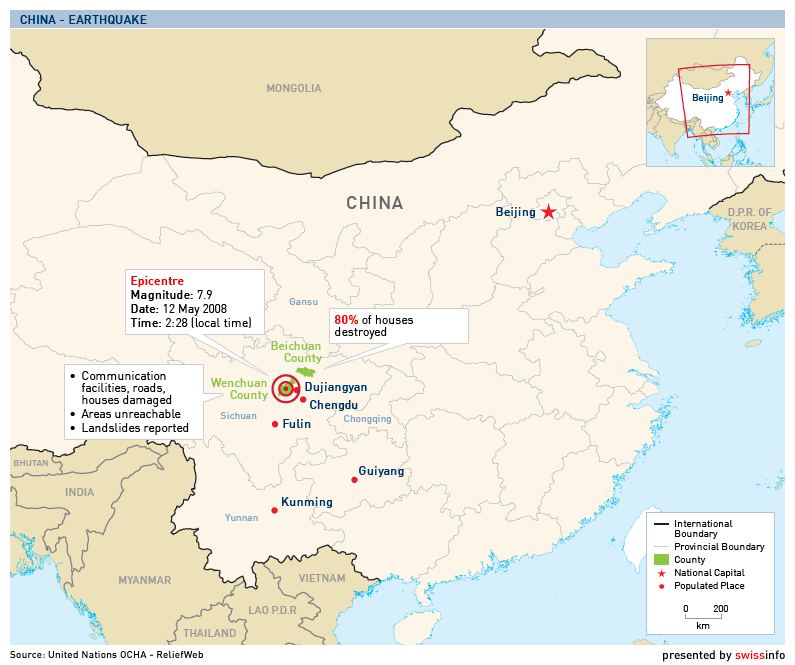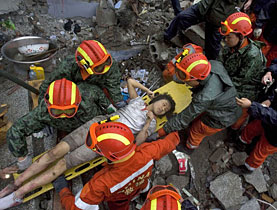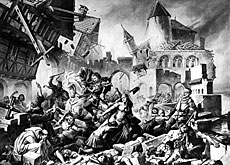Europe should ponder lessons of Chinese quake

An earthquake of the same magnitude as the one in China would have caused similar damage in Europe, a Swiss expert tells swissinfo.
Thomas Wenk, chairman of the Swiss Society for Earthquake Engineering and Structural Dynamics, was speaking in the wake of Monday’s earthquake, which has left at least 15,000 dead.
He said that while Switzerland is in a lower risk category than most of China, an earthquake of similar strength could occur in other parts of Europe.
swissinfo: Measured by the number of victims, the earthquake in China was one of the worst of the past few years. How strong was the quake in comparison to others?
Thomas Wenk: Evaluating it after the event, the US Geological Survey (USGS) estimated it at a magnitude of 7.9.
That puts it among the strongest quakes. But every year there are about ten earthquakes of this magnitude worldwide.
Its magnitude is comparable with that in Taiwan in 1999, for example. The quakes that caused the tsunami were considerably stronger, with a magnitude of more than nine.
But what is important is not just the magnitude but where the area of main impact lies in relation to populated areas. Most earthquakes occur in the sea. Then no one is affected, except by a tsunami.
swissinfo: How do things look in China in particular?
T.W.: The fracture surface is about 300 kilometres long. Looking at it from 6,000 kilometres distance, I see it going through the northwest of the populated area. The main area of damage is in a strip about 30 to 50km wide and 300km long.
The larger cities like Chengdu are nearly 100km away. That means that they are much less affected.
Then you must take into account the fact that this quake was at a depth of only 10km, which is very close to the surface. That means that it had a much greater impact.
And the earth tremors which affect buildings are greater in this strip. No building can survive these tremors unless it has been specially designed to do so.
swissinfo: So the huge amount of damage isn’t mainly because the buildings are poorly built?
T.W.: It’s because it occurred in an area where people live. I cannot estimate the population density of this area. But the region is mainly mountainous, otherwise there would have been many more victims.
swissinfo: In general, what is the building fabric like in China?
T.W.: China has modern quake norms. There are all shades of risk in the country, from practically quake-free to the highest risk regions in the world, to the west in the direction of the Himalayas.
And they have modern quake norms designed to match. But of course these only go back for about 15 years, not a thousand.
swissinfo: What are the differences between the Chinese building regulations and those in force in Switzerland?
T.W.: They are calculated according to the relevant risk. The affected area is classified as medium risk worldwide.
That is more than the highest risk in Switzerland. In Switzerland we are in the lower bracket except in canton Valais, which is at the very lower end of the medium risk category. The area that has been affected in China would be classified as at somewhat greater risk than Valais.
But whether the norms are applied everywhere in the valleys there and how old the buildings are I cannot say. In this area it is reasonable to presume that everything collapsed that wasn’t build to withstand earthquakes.
swissinfo: What damage would a quake of this magnitude cause in Switzerland?
T.W.: It would be comparable. It always depends on whether the area is prepared for it or not.
I am not a seismologist, but in Europe an earthquake on that scale could only be imagined in the main risk areas towards Turkey and Asia. Such a strong earthquake needs a huge fracture area.
swissinfo: Have the buildings for the Olympic Games been constructed according to the new norms?
T.W.: I only know about this from a distance, and wouldn’t like to say anything definite about it. But I know from the planning documents that strict earthquake norms are in force for Beijing.
Beijing is in the medium risk category. It can be presumed that all the newer buildings have been constructed according to earthquake norms.
What is important is that they should be implemented on the construction site. So as far as quake-proof building is concerned, the details count for quite a lot. And I don’t know how exactly building controls work in China.
It is not enough to deal with these questions at the drawing board; they have to be implemented correctly and checked down to the last detail.
swissinfo-interview: Christian Raaflaub
More than a million tremors are measured world wide each year.
Fifteen per cent of the earth’s surface is at risk of suffering a severe quake.
Earthquakes occur mainly in regions at the edge of tectonic plates.
Ninety per cent of all the earthquakes measured in the world occur around the Pacific rim.
Earthquakes can be measured with highly sensitive seismographs, which can also be used to show the distance of the quake.
Modern earthquake research uses the so-called moment magnitude to express the strength of quakes. This has replaced the Richter scale.
In calculating moment magnitude it is not the energy released by the quake which is measured, but the length of the fracture in the earth’s crust. This may be a few hundred metres, but it may also be hundreds of kilometres.


In compliance with the JTI standards
More: SWI swissinfo.ch certified by the Journalism Trust Initiative














You can find an overview of ongoing debates with our journalists here . Please join us!
If you want to start a conversation about a topic raised in this article or want to report factual errors, email us at english@swissinfo.ch.